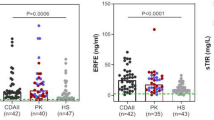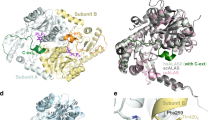Abstract
Congenital erythropoietic porphyria (CEP) or Günther’s disease is an inborn error of heme biosynthesis transmitted as an autosomal recessive trait and characterized by a profound deficiency of uroporphyrinogen III synthase (UROIIIS) activity. Six missense mutations in the UROIIIS gene, a deletion and an insertion have already been described in CEP. This work brings further evidence for the heterogeneity in the genetic defect found in CEP. Two new mutations are described, a point mutation (V99A) and a frame-shift mutation (633insA) in the same patient who had a mild to moderate form of Günther’s disease. The mutation (V99A) had a detectable residual activity when expressed in Escherichia coli while the insertion (633insA), which introduced a premature stop, had no activity. In the patients studied in our laboratory, the mutation C73R, associated with a severe phenotype, remains the most frequently seen.
Similar content being viewed by others
Introduction
Porphyrias are a group of inherited disorders caused by specific defects along the heme biosynthetic pathway. Congenital erythropoietic porphyria (CEP) or Günther’s disease is a rare disease that is inherited as an autosomal recessive trait. CEP is characterized by severe cutaneous photosensitivity, chronic hemolysis and massive porphyrinuria resulting from the accumulation in the bone marrow, peripheral blood and other organs, of large amounts of predominantly type-I porphyrins, which are not substrates for heme synthesis [1]. A characteristic abnormality of the disease is a 80–98% decrease in the activity of uroporphyrinogen III synthase (UROIIIS), the fourth enzyme of the heme biosynthetic pathway (hydroxymethylbilane hydrolase [cyclizing], EC 4.2.1.75) [2, 3]. This enzyme activity is estimated from peripheral erythrocytes and does not represent the total nucleated cells involved in heme synthesis. The determination of the nucleotide sequence of the cDNA encoding UROIIIS [4] has made it possible to study the molecular lesions responsible for the disease and eight different mutations have been described: six point mutations (L04F, T53M, T62A, A66V, C73R and T228M); a deletion 148del98, and an insertion 660ins80.
In the present paper, we describe the identification of two new missense mutations on the UROIIIS gene in the same patient and the analysis of the mutant protein through heterologous expression in Escherichia coli.
Patient and Methods
The patient came from South Africa and displayed a moderate form of CEP diagnosed at age 14. The patient gave a history of skin fragility and frequent blistering of sun exposed areas since early childhood. Typical features were observed: scarring; hyperpigmentation; temporal hirsutes; blistering of the face, and erythrodontia. Although the fingers showed evidence of photomutilation with brachydactyly, thickening of the skin over the joints and a reduced range of movement, the patient was able to lead a relatively normal life. Splenomegaly and mild hemolysis were also noted.
Erythrocyte and urinary porphyrins were determined by high-performance liquid chromatography as previously described [5]. UROIIIS activity was measured in a lymphoblastoid cell line, using a method adapted from Tsai et al. [6]. Two methods were combined for the analysis of the UROIIIS gene: allele-specific oligonucleotide hybridization and direct sequencing of in vitro amplified (polymerase chain reaction, PCR) fragments from genomic DNA [7]. However, only half of the coding sequence of the UROIIIS gene could be screened from genomic DNA. In order to explore the entire cDNA sequence, a lymphoblastoid cell line was obtained from peripheral blood of the patient, and total RNAs were prepared according to Chomszinski and Sacchi [8]. RNAs were reverse transcribed using oligo(dT) as primer and the entire UROIIIS cDNA was amplified using oligonucleotides US7E and US4 as previously described [9], and cloned into the plasmid Bluescript pKS (Stratagene) for sequence determination. The nomenclature suggested by Beaudet and Tsui [10] is used to designate the mutations identified by sequencing. One mutated cDNA (V99A) was cloned directly into the expression vector pKK 223.3 (Pharmacia, France) while the other mutated cDNA (633insA) had to be constructed by mutagenesis using sequential PCR steps [11] from a normal pKK UROIIIS clone. These constructs enabled the determination of UROIIIS activity of the mutant protein expressed by E. coli [9].
Results
Quantitative porphyrin estimation by high-performance liquid chromatography was typical of CEP with up to 90% of the porphyrins present as the series-I isomer (table 1). UROIIIS activity of the lymphoblastoid cell line showed a 95% decrease in activity when compared to a normal control: 0.43 U/h/mg protein (control = 9.5 U/h/mg).
The molecular analysis started with a systematic screening of known point mutations [7, 9, 12, 13]: none of them was observed (L04F, P53L, T62a, A66V, C73R, and T228M). The amplified cDNA had a normal size and eight clones were obtained in pKS: one showed two mutations and seven were identical with a single base substitution at codon 99 (GTT → GCT) corresponding to a missense mutation from Val to Ala designated as V99A. In the single clone, the first mutation was a single base substitution at codon 169 (CAG → CGG) corresponding to a missense mutation from Gln to Arg (Q169R), the second mutation was the insertion of an A at position 633 on the nucleotide sequence (633insA), resulting in a frameshift mutation which introduced a premature stop at codon 213. The missense mutation V99A observed in cDNA clones was also present in genomic DNA amplified with the primer set 4 from Warner et al. [7] as shown in figure 1. The missense mutation Q169R was not detectable on the cDNA prior to cloning as assessed by ASO hydridization and was considered as a PCR artifact. The frameshift mutation 633insA introduced a new Mse I restriction site and was clearly identified on the cDNA prior to cloning as shown in figure 2. Finally, the patient was identified as a heteroallelic V99A/633insA.
Sequence determination of the missense mutation V99A: analysis at the cDNA and the genomic level. Upper panel: Sequence of normal and mutated cDNA cloned into pKS vector. Lower panel: Sequence of the corresponding exon from genomic DNA. Sequencing was performed by the dideoxy chain termination method (T7 sequencing kit, Pharmacia, France) on single-stranded biotinylated PCR fragments purified on Streptavidine magnetic beads (Streptavidine M280, Biosys, France).
Sequence and restriction analysis for the mutation 633insA. Upper panel: Sequence of normal and mutated cDNA cloned into pKS vector. Lower panel: Restriction analysis of the amplified cDNA prior to cloning. The mutation creates an Mse I site and generates a new 136-bp fragment in the patient amplified cDNA (No. 2) as well as in the cloned cDNA (No. 3). The Mse I site is absent in control cDNA (No 4) and in the cloned cDNA (No 1) where two restriction fragments are seen (163 and 156 bp). The uncut fragment is 319-bp long (No. 5).
In order to demonstrate the pathologic significance of the mutations, the mutant proteins were expressed in E. coli to determine UROIIIS activity. The expression vector pKK V99A was obtained from a single cloning step. The expression vector pKK 633insA mutant was constructed by mutagenesis from a normal pKK UROIIIS clone because the original pKS cDNA had two mutations (633insA and the PCR artifact Q169R). Results of expression are given in table 2: the frame-shift mutation 633insA showed no residual activity while the missense mutation V99A exhibited a low residual activity (7%) when compared to the normal pKK UROIIIS.
Discussion
In this study, two new mutations on the UROIIIS gene were characterized in the same South African patient. This result brings further evidence for the heterogeneity of the mutations in CEP. Interestingly, a direct correlation was observed between phenotype and genotype since the patient suffered from a mild form of CEP and exhibited a mutated allele (V99A) expressing some residual UROIIIS activity (7%). On the other hand, the second mutated allele (633insA) had no activity in the expression system as previously seen with C73R, 148del98 and 660ins80 alleles [9]. A total of 17 unrelated patients have been analyzed in our laboratory: the C73 allele has been detected in 16 of 34 alleles. It is of note that this allele is readily associated with a severe phenotype [13, 14] when the patient is homoallelic while the phenotype of heteroallelic individuals depends on the lesion present on the other allele.
The expression system used in this work is well suited to enzymatic analysis and correlations between phenotype and genotype, but gives little information on the relation between structure and function. Actually, we are developing another expression system, pGEX (Pharmacia, France), which allows a large overproduction of recombinant proteins for purification and cristallographic studies.
The analysis of mutated alleles by direct sequencing of UROIIIS exons from genomic DNA is a convenient way to identify new mutations. However, the frameshift mutation 633insA could not be analyzed by genomic sequencing because UROIIIS gene structure has not been published so far and we could not design convenient genomic amplimers. More gene cloning work is necessary to enable the amplification of the entire coding sequence from genomic DNA. Finally, the improvement of diagnosis methods in unclassified cases of porphyrias will benefit genetic counselling and prenatal diagnosis.
References
Kappas A, Sassa S, Galbraith RA, Nordmann Y: The porphyrias; in Scriver CR, Beaudet AL, Sly WS, Valle D (eds): The Metabolic Basis of Inherited Disease. New York, McGraw Hill, 1989, pp 1305–1365.
Romeo G, Levin EY: Uroporphyrinogen III cosynthase in human congenital erythropoietic prophyria. Proc Natl Acad Sci USA 1969;63;856–863.
Deybach JC, de Verneuil H, Phung N, Nordmann Y, Puissant A, Boffety B: Congenital erythropoietic porphyria (Günther’s disease): Enzymatic studies on two cases of late onset. J Lab Clin Med 1981;97:551–558
Tsai SF, Bishop DF, Desnick RJ: Human UROIII-S: Molecular cloning, nucleotide sequence and expression of a full-length cDNA. Proc Natl Acad Sci USA 1988;85:7049–7053
Lim CK, Rideout JM, Wright DJ: Separation of porphyrin isomers by high performance liquid chromatography. Biochem J 1983;211:435–438
Tsai SF, Bishop DF, Desnick RJ: Coupled-enzyme and direct assays for uroporphyrinogen III synthase activity in human erythrocytes and cultured lymphoblasts. Anal Biochem 1987;166:120–133
Warner CA, Yoo HW, Roberts AG, Desnick RJ: Congenital erythropoietic porphyria: Identification and expression of exonic mutations in the uroporphyrinogen III synthase gene. J Clin Invest 1992;89:693–700
Chomczynski P, Sacchi N: Single-step method for RNA isolation by acid guanidium thiocyanate-phenolchloroform extraction. Anal Biochem 1987;162:156–159
Boulechfar S, Da Silva V, Deybach JC, Nordmann Y, Grandchamp B, de Verneuil H: Heterogeneity of mutations in uroporphyrinogen III synthase gene in congenital erythropoietic porphyria. Hum Genet 1992;88:320–324
Beaudet AL, Tsui LP: A suggested nomenclature for designating mutations. Hum Mutat 1993;2:245–248
Cormack B: Mutagenesis by polymerase chain raction. Curr Protocols Mol Biol 1991;1(suppl 15):8.5.1–8.5.9.
de Verneuil H, Deybach JC, Grandchamp B, Nordmann Y: Coexistence of two point mutations in the uroporphyrinogen III synthase gene in one case of congenital erythropoietic porphyria (abstract). Blood 1989;74:105.
Deybach JC, de Verneuil H, Boulechfar S, Grandchamp B, Nordmann, Y: Point mutations in the uroporphyrinogen III synthase gene in congenital erythropoietic porphyria. Blood 1990;75:1763–1765
Verstraeten L, Van Regemorter N, Pardou A, de Verneuil H, Da Silva V, Rodesch F, Vermeylen D, Donner C, Noël JC, Nordmann Y, Hassoun A: Biochemical diagnosis of a fatal case of Günther’s disease in a newborn with hydrops foetalis. Eur J Clin Chem Clin Biochem 1993;31:121–128
Acknowledgements
The authors wish to thank all the physicians for providing patient specimens. This work was supported by grants from Association française contre les Myopathies, Fondation pour la Recherche médicale, Ministère de la Recherche et de l’Espace and Conseil Régional d’Aquitaine. We thank Maïté Sanchez for the preparation of the manuscript.
Author information
Authors and Affiliations
Rights and permissions
About this article
Cite this article
Bensidhoum, M., Ged, C., Hombrados, I. et al. Identification of Two New Mutations in Congenital Erythropoietic Porphyria. Eur J Hum Genet 3, 102–107 (1995). https://doi.org/10.1159/000472283
Received:
Revised:
Accepted:
Issue Date:
DOI: https://doi.org/10.1159/000472283
Key Words
This article is cited by
-
Mutational analysis of uroporphyrinogen III cosynthase gene in Iranian families with congenital erythropoietic porphyria
Molecular Biology Reports (2012)
-
Congenital Erythropoietic Porphyria: Prenatal Diagnosis and Autopsy Findings in Two Sibling Fetuses
Pediatric and Developmental Pathology (2001)
-
A novel point mutation in congenital erythropoietic porphyria in two members of Japanese family
Human Genetics (1996)





